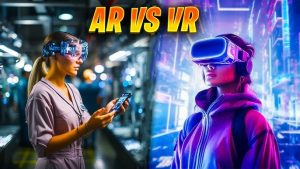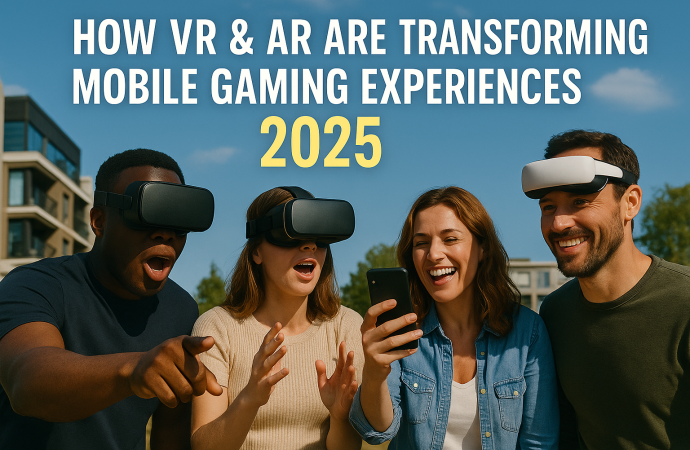Introduction Imagine stepping into a world where monsters leap off your screen into your living room or where you explore alien planets by turning your phone. In 2025, VR mobile gaming and AR gaming experiences have reached new heights. These technologies blend virtual and real physical worlds, making mobile gaming in 2025 more immersive and
Introduction
Imagine stepping into a world where monsters leap off your screen into your living room or where you explore alien planets by turning your phone. In 2025, VR mobile gaming and AR gaming experiences have reached new heights. These technologies blend virtual and real physical worlds, making mobile gaming in 2025 more immersive and interactive than ever. From lightweight VR headsets to AR-driven treasure hunts, this article explores how these trends revolutionize gameplay. You’ll learn about top apps, hardware, design principles, and practical tips to dive into mixed reality gaming today. Ready to level up your play? Let’s explore the future of mobile games.
What Are VR and AR in Mobile Gaming?

Image by: Yandex.com
Virtual reality (VR), like VR Brille, virtuelle Objekte, and virtuelle Welt in mobile gaming, uses headsets or goggles to place players inside a fully digital environment. Everything you see comes from the game, and you interact using controllers or hand tracking. VR games can transform your room into a battlefield or a concert hall.
Augmented reality (AR), like AR Brillen or AR Anwendung, overlays digital elements onto your real-world view through your phone’s camera. AR games like treasure hunts or pet simulators blend seamlessly with your home or backyard. Combined, VR and AR create mixed reality experiences where virtual and real virtual worlds merge.
Why VR and AR Matter for Mobile Gamers in 2025

Image by: Yandex.com
By 2025, smartphones and wearables have enough power and sensors for smooth VR and AR. This matters because mobile adoption is global—billions of players can access mixed reality. No more expensive PCs or consoles: a phone and a cheap headset deliver 6DOF tracking, high frame rates, and true immersion.
These technologies boost engagement: players stay longer, explore more, and share experiences on social media. Brands and educators also use AR for interactive marketing and training apps. For gamers and creators, VR and AR open new frontiers of design and community.
Key Hardware Advances for Mobile VR & AR

Image by: Yandex.com
Recent hardware innovations make VR and AR on phones possible:
- Snapdragon XR Chips: Specialized processors handle 3D graphics and spatial tracking with low power draw.
- Inside-Out Tracking Headsets: Devices like the Meta Quest 3 now tether to phones, using built-in cameras for room-scale VR without external sensors.
- AR Glasses Prototypes: Several companies unveiled thin AR glasses that stream content from phones, offering hands-free augmented experiences.
- Haptic Feedback Accessories: Lightweight controllers and gloves provide tactile response, making digital objects feel real.
These gadgets lower barriers to entry and improve comfort for longer sessions.
Immersive Gameplay Trends in 2025

Image by: Yandex.com
Mobile gaming 2025 sees several standout trends:
- Location-Based AR Adventures: Players hunt virtual items in real-world locations, blending scavenger hunts with social meetups.
- Shared Virtual Spaces: Multiple players join a private VR room via mobile headsets to watch events, play games, or collaborate on puzzles.
- AI-Driven NPCs: Virtual characters respond to voice and gesture in real time, thanks to on-device AI. They offer dynamic storylines and personalized challenges.
- Cross-Platform Mixed Reality: Games sync progress between mobile, console, and VR, letting you switch seamlessly.
These trends keep content fresh and encourage social play beyond solo sessions.
Designing for Mixed Reality Best Practices

Image by: Yandex.com
Good immersive gameplay design balances digital and real. Key tips:
- Comfort First: Avoid motion sickness with stable frame rates (90+ FPS) and limited acceleration. Implement snap turning for locomotion.
- Context Awareness: Use GPS, compass, and depth sensors to anchor AR objects naturally in the environment.
- Simplify Controls: Mobile VR benefits from gaze-based menus and minimal controller buttons. AR uses touch and simple gestures.
- Audio Cues: Spatial audio guides players to objectives and enhances immersion.
- Safety Boundaries: Warn players when they approach real-world obstacles. Use guardian systems to prevent collisions.
These practices ensure enjoyable and safe experiences.
Top VR and AR Mobile Games of 2025

Image by: Yandex.com
Several standout titles lead the pack:
- SkyRealms AR: Build and defend floating islands in your backyard, teaming up or battling friends across cities.
- QuestDive VR: Dive into deep-sea expeditions, solving puzzles and discovering lost civilizations from your couch.
- Mystic Hunt AR: A location-based RPG where you catch mythical creatures and complete dungeons in real-world parks.
- BeatVerse VR: Rhythm game with user-generated levels, playable solo or in VR parties with friends on mobile devices.
These apps showcase the power and variety of mobile mixed reality.
Monetization Models in VR & AR Games

Image by: Yandex.com
Developers use varied models:
- Free-to-Play with Microtransactions: Cosmetic skins, new quests, and custom items keep revenue flowing.
- Subscription Passes: Monthly fees unlock premium worlds and exclusive events.
- One-Time Purchase: Premium titles charge up front, with optional DLC to extend play.
- Ad-Supported AR: Non-intrusive ads appear on virtual billboards in location-based games. Players earn rewards for watching brief clips.
Choose a model that fits your audience casual players prefer free, while enthusiasts invest in premium content.
Challenges and Solutions in Mobile Mixed Reality
Mixed reality on mobile faces hurdles:
- Battery Drain: High graphics and sensors burn power quickly. Solution: optimize assets, use frame skipping, and allow lower-power modes.
- Overheating Phones: Case-integrated heatsinks and app power throttling help. Developers should warn users after long sessions and recommend breaks.
- Device Fragmentation: Hundreds of Android and iOS models exist. Use adaptive graphics settings and test on mid-range devices.
- Privacy Concerns: AR maps and camera feeds raise data risks. Implement on-device processing and clear user permissions.
Addressing these issues ensures user trust and better experiences.
Future Outlook for VR & AR in Mobile Gaming

Image by: Yandex.com
Looking ahead, we’ll see:
- Edge Computing: Offload heavy AI and graphics to nearby edge servers for ultra-smooth performance on low-end phones.
- True AR Wearables: Mass-market AR glasses with phone tethering, freeing up hands and pockets.
- Haptic Suits and Gloves: Affordable wearables that simulate touch, temperature, and resistance.
- Metaverse Integration: Shared persistent worlds that combine VR, AR, mixed reality (MR), and traditional screens into one experience.
These advances will blur lines between digital and real, making mobile gaming truly limitless.
Comparative Table: Comparing VR & AR Monetization Models
| Model | Pros | Cons | Best For |
|---|---|---|---|
| Free-to-Play + Microtransactions | Low barrier to entry, high revenue | Can feel “pay-to-win” | Casual and social games |
| Subscription Passes | Predictable income, engaged users | Requires ongoing content updates | Premium world-building titles |
| One-Time Purchase + DLC | Clear value, no ads | Harder to attract initial users | High-quality standalone games |
| Ad-Supported AR | Free play, advertiser funding | Risk of ad fatigue | Location-based and casual AR |
Conclusion
VR mobile gaming and AR gaming experiences are reshaping mobile gaming 2025. With powerful chips and smart designs, developers create immersive adventures in your living room and beyond. By following best practices comfort design, context awareness, and simple controls—you deliver top-notch experiences. Monetize wisely with free-to-play, subscriptions, or premium purchases. Address battery, heat, and privacy challenges head-on. As edge computing, AR wearables, and the metaverse emerge, the future shines for mixed reality gamers.
Call to Action
Ready to explore the next level? Download our VR & AR guide today and start building your own immersive mobile game experience!
















